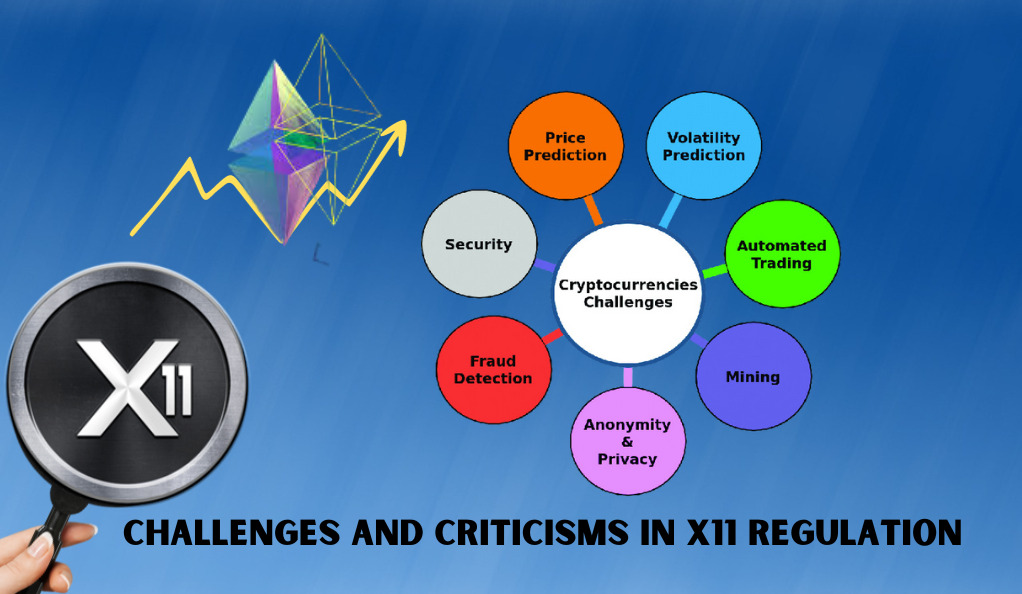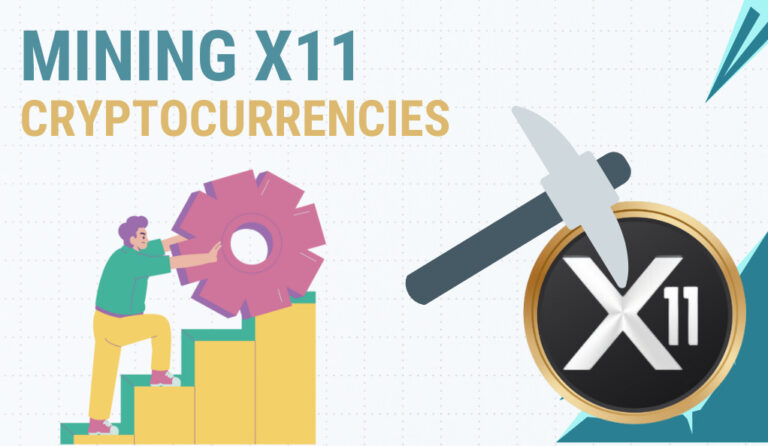The dawn of the cryptocurrency era, marked by the inception of Bitcoin, unveiled a revolutionary digital frontier with a promise of decentralized financial control, transparency, and reduced reliance on traditional banking systems. With Bitcoin’s underlying proof-of-work algorithm – SHA-256 – gaining prominence, other cryptographic algorithms started to emerge, seeking to improve on different aspects, from security to energy efficiency. Among these, the X11 algorithm stood out, offering a unique blend of features that made it both intriguing and appealing to crypto enthusiasts.
What is X11?
X11 is not merely another cryptographic algorithm. Instead, it is a chained hashing algorithm that utilizes eleven different cryptographic hashes sequentially. Designed by Evan Duffield, the creator of Dash (originally known as Darkcoin), X11’s primary goal was to enhance the security of the cryptographic process and offer a more power-efficient solution compared to SHA-256.
Significance in the Crypto World
X11’s introduction was timely. At a period when concerns about Bitcoin’s energy consumption started making headlines, an algorithm promising reduced power consumption was indeed a welcome alternative. Furthermore, its ASIC resistance, albeit short-lived, promised to democratize mining operations, potentially putting the power back into the hands of individual miners and reducing the influence of large mining pools.
Moreover, the coins based on the X11 algorithm, with Dash being the most prominent, began to gain traction, offering features like faster transaction times, private transactions, and decentralized governance systems. The unique architecture and promising features of X11 thus brought in a new wave of interest and investment, positioning it as a significant player in the expanding cryptocurrency universe.
Key Features of X11
- Chained Hashing: It incorporates 11 distinct hashing functions to enhance security and resilience against potential attacks.
- Energy Efficiency: X11 consumes notably less power compared to many other hashing algorithms, making it environmentally friendly and cost-effective for miners.
- Adaptive N-factor: This feature allows X11 to adapt its hashing requirements based on network demands, ensuring ongoing efficiency.
- ASIC Resistance: X11 was initially designed to discourage the development of specialized mining hardware, promoting decentralization within cryptocurrency networks.
The Importance of Cryptocurrency Regulation
The meteoric rise of cryptocurrencies and their underlying technologies has prompted discussions, debates, and concerns on a global scale. While these digital assets bring forth a myriad of opportunities, such as financial inclusivity and enhanced security, they also introduce challenges, particularly in the realms of consumer protection, financial stability, and crime prevention.

Why Regulation is Necessary in the Crypto World
- Consumer Protection: With the growing number of investors venturing into the cryptocurrency market, many of whom are novices, there’s a rising concern about potential fraud, scams, and the volatile nature of crypto investments. Regulations ensure that crypto platforms maintain transparency, accountability, and provide adequate information to their users.
- Financial Stability: The large-scale adoption of cryptocurrencies could potentially threaten traditional financial systems, especially if left unchecked. By monitoring and setting guidelines for crypto transactions, regulators can mitigate systemic risks and prevent possible financial crises.
- Preventing Illicit Activities: Cryptocurrencies have been notoriously associated with illegal activities, from money laundering to funding terrorism. A robust regulatory framework can deter criminals by imposing strict identity verification processes and monitoring large or suspicious transactions.
- Promoting Innovation: Counterintuitive as it might seem, regulations can actually foster innovation. Clear guidelines can attract institutional investors, promote healthy competition, and provide a stable environment for startups to thrive.
Balancing Freedom of Innovation with Security and Protection
While the essence of cryptocurrencies lies in decentralization and autonomy, complete deregulation can lead to chaos, with potential negative repercussions for both individual investors and the broader financial ecosystem. Thus, the objective of any regulatory framework should not be to stifle innovation but to nurture a safe and sustainable environment for it.
It is a delicate dance, one that requires understanding the nuances of the crypto world and foreseeing its potential trajectory. Different countries have taken varied approaches, with some opting for a more open regulatory framework, while others tread with caution, imposing stringent rules.
Global Regulatory Differences
The vast and decentralized nature of the cryptocurrency world, combined with the rapid pace of technological advancements, has led to a patchwork of regulatory responses across the globe. Different nations, driven by their unique economic, political, and societal contexts, have forged distinct pathways in their approach to regulating X11 and other digital assets.
Overview of Varied Regulatory Approaches
- Embracing Cryptocurrencies: Some nations have chosen to embrace cryptocurrencies fully, viewing them as the future of finance and a potential catalyst for economic growth. By offering tax incentives, establishing crypto-friendly regulations, and even considering the development of Central Bank Digital Currencies (CBDCs), these nations aim to become hubs of crypto innovation.
- A Cautious Stance: Many countries, while not completely averse to the idea of cryptocurrencies, maintain a cautious approach. They often permit cryptocurrency activities but under a strict regulatory regime, focusing on preventing money laundering, tax evasion, and fraud. Licensing requirements and investor protection measures are common features in these jurisdictions.
- Restrictive Measures: A subset of nations perceives cryptocurrencies as a potential threat to their financial sovereignty or fears its use in illicit activities. Such countries might impose complete bans on cryptocurrency trading, mining, or even possession. Some have even penalized crypto-related activities with hefty fines or imprisonment.
Regions/Countries and Their Stance on X11 Cryptocurrencies
US: The United States, while initially cautious, has evolved to become more accepting of cryptocurrencies. Regulatory bodies such as the Securities and Exchange Commission (SEC) and the Commodity Futures Trading Commission (CFTC) have set guidelines, primarily treating cryptocurrencies as securities or commodities. Specific states, like Wyoming, have also established crypto-friendly regulations.
EU: The European Union, with its diverse member states, offers a mixed bag of regulatory approaches. While the European Central Bank (ECB) has expressed concerns about the potential risks of cryptocurrencies, member countries like Malta and Estonia have established themselves as crypto havens with progressive regulations.
Asia: The Asian landscape is incredibly varied. While China has taken a restrictive stance, especially concerning crypto mining and trading, nations like Japan and South Korea have established clear regulatory frameworks, recognizing cryptocurrencies and ensuring that exchanges operate under strict guidelines.
Challenges and Criticisms in X11 Regulation
The task of regulating an ever-evolving technological space like cryptocurrency is complex. It not only requires in-depth technical knowledge but also foresight into the potential shifts in the global financial landscape. With X11 cryptocurrencies as our lens, let’s explore the primary challenges faced by regulators and the criticisms they encounter from the crypto community.

Hurdles in Crafting Suitable Policies
- Rapid Technological Evolution: The swift pace at which crypto technologies change can make it difficult for regulations to stay current. By the time a regulatory policy is implemented, the technology or its application might have evolved, rendering the rule outdated or less effective.
- Decentralized Nature: At the heart of cryptocurrencies lies the principle of decentralization, which poses a significant challenge to traditional regulatory approaches. How does one regulate something that isn’t controlled by a centralized entity?
- Jurisdictional Issues: Cryptocurrencies operate on a global scale, often blurring national boundaries. Determining jurisdiction in cases of disputes or fraud becomes a convoluted task, leading to potential legal ambiguities.
- Varied Classification: Cryptocurrencies can be viewed as commodities, securities, currencies, or even property, depending on their function and the context in which they are used. This varied classification complicates the regulatory approach, as different rules may apply based on the chosen classification.
Common Criticisms from the Crypto Community

Stifling Innovation: One of the most prevalent criticisms is that stringent regulations can stifle innovation. When startups face onerous compliance requirements, they may be deterred from experimenting or entering the market.
Lack of Clarity: Ambiguous regulations can lead to uncertainty, making it difficult for businesses to plan their operations. A clear, concise regulatory framework is often demanded by crypto enthusiasts and businesses alike.
Overreach and Privacy Concerns: The crypto community values privacy, and regulations demanding extensive user information or backdoor access to platforms are often met with skepticism or outright resistance.
One-Size-Fits-All Approach: Treating all cryptocurrencies under the same regulatory umbrella can be problematic. The wide variety of digital assets, each with its unique features and purposes, might require tailored regulatory approaches.
Future Outlook: What Lies Ahead for X11 Cryptocurrency Regulation
As the landscape of digital currencies continues to evolve, so too does the world’s perception and subsequent regulatory stance on them. Drawing insights from historical patterns and current global sentiments, let’s postulate the potential directions of X11 cryptocurrency regulations.
Adoption of Best Practices
With many countries actively experimenting and refining their crypto regulatory approaches, there is a growing pool of knowledge and experiences to draw from. Nations will likely observe and adopt best practices from each other, leading to more informed and effective regulations.
Increased Collaboration among Nations
The global nature of cryptocurrencies necessitates international cooperation. In the coming years, we might witness more collaborative efforts between countries to devise regulations that not only serve national interests but also promote a more harmonized global crypto ecosystem.
Greater Emphasis on Consumer Education
While regulations aim to protect consumers, an educated user base is the first line of defense against frauds and scams. Governments and regulatory bodies might increase their efforts in disseminating knowledge about cryptocurrencies, their benefits, and associated risks.
Refined Definitions and Classifications
As the crypto space matures and diversifies, regulators will have to revisit and possibly refine their definitions and classifications of cryptocurrencies. This would entail a more nuanced understanding of different types of digital assets and crafting regulations that cater to their unique characteristics.
Integration with Traditional Financial Systems
There’s a growing trend of cryptocurrencies becoming more intertwined with traditional financial systems, whether through crypto-backed financial products, integration with payment gateways, or collaboration with banks. This convergence will likely necessitate revisited regulations, ensuring that the amalgamation is seamless and safe.
The Rise of Decentralized Finance (DeFi)
DeFi platforms, which aim to replicate and innovate traditional financial functions like lending, borrowing, and trading on blockchain, are gaining traction. As they grow, their intersection with X11 and other cryptocurrencies will draw regulatory attention, especially given the potential risks and rewards associated with them.
Balancing Act Between CBDCs and Cryptocurrencies
With many countries exploring or actively developing their own Central Bank Digital Currencies (CBDCs), there will be interesting dynamics between CBDCs and other cryptocurrencies. Regulations might evolve to define the relationship between state-backed digital currencies and decentralized cryptocurrencies, with a focus on ensuring stability and complementarity.
Conclusion
The journey of X11 and other cryptocurrencies through the complex maze of global regulations offers a captivating glimpse into the ongoing tussle between innovation and governance. As digital assets find their footing in the ever-shifting sands of the global financial landscape, they challenge traditional norms and compel nations to reevaluate established frameworks.
Moving forward, the hope lies in harmonizing this dynamic dance, ensuring that while the flames of innovation continue to burn bright, they are guided by the lanterns of safety, transparency, and consumer protection. The evolution of cryptocurrency regulations is more than just a bureaucratic endeavor; it’s a testament to humanity’s adaptability in the face of disruptive change.
At axerunners.com, our goal is to furnish well-rounded and trustworthy information regarding cryptocurrency, finance, trading, and stocks. Nonetheless, we avoid providing financial advice and instead encourage users to conduct their own research and meticulous verification.
Read More













